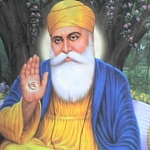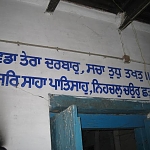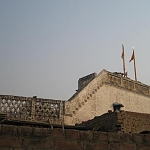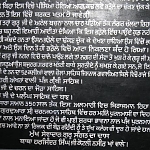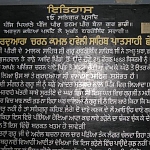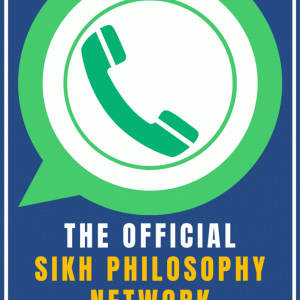Media
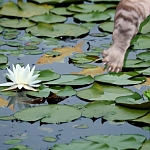
Fish Pond I decided to day that I was going to leave the Snippy Goldfish family and do a more serious illustration-collage. I had found a tuk in Sri Guru Granth Sahib ji about being a frog and wanted to illustrate it. I went to Creative Commons and found this beautiful pond with the little green frog and the beautiful water lily/lotus. Somehow the pond cried out for some fish and then that cat showed up. Poor Snippy!
- Mai Harinder Kaur
- Aug 25, 2010
- 0
- 0
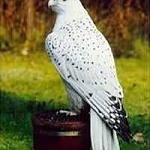
The "white" falcon of Sri Guru Gobind Singh was actually the GyrFalcon or Gray Falcon, in old Punjabi "baaj." "Once Guru Gobind Singh Ji was in the forest and he let the baaj fly off towards a small animal scurrying about in the undergrowth. The baaj caught the animal and flew back to the Guru. It tore at the animal and fed on it. The accompanying Sikhs were taken aback by this incident and asked Guru Ji to explain. “In a previous time the baaj and this animal were friends. The one who is now dead asked for a loan and swearing on the Almightys name said that he would pay it back. He was devious and never did return it, so this is payback time.” In this incident Guru Ji enlightened his Sikhs that if you take something that is not yours or promise to return it then you will be held to that promise no matter what. 'The most significant story concerning the baaj is in 1699 when Guru Sahib Ji had created Amrit (holy nector) for the precise purpose of creating the Khalsa brotherhood. A few drops of amrit had fallen from the iron cauldron, which were readily consumed by a few sparrows. The sparrows turned onto the baaj and repeatedly assaulted him to such an extent that he had to take flight, followed vigorously by the sparrows. This incident showed the Sikhs that the amrit created by the Tenth Guru had immense power, after drinking a few drops a small sparrow not only had the courage to take on a bird of prey but to harassed it until it took flight and fled. Guru Gobind Singh Ji said “I will create my Khalsa of such courage and vigour that he will take on armies of the enemy, he will stand up for the poor and the downtrodden – Sava Lakh say ek ladaho (One will confront a lakh and a quarter of the enemy)” 'In 1984 amongst the turmoil and terrible fate of so many Sikhs a white baaj appeared, seen by many it circled and perched on a branch, telling the Sikhs that the Guru was with them. 'From time to time a white baaj is seen in the mountains of the Himalayas in the surrounding areas of Hemkund Sahib where Guru Gobind Singh Ji performed much hard meditation to merge with the Almighty. " More at this site: Source http://www.info-sikh.com/BaajGyr4.jpg
- spnadmin
- May 13, 2008
- 0
- 2

Singh Modern Punjabi n sher. M; shinh. M; babar sher. M; ਏਕੁ ਅਚੰਭਉ ਸੁਨਹੁ ਤੁਮ੍ਹ੍ਹ ਭਾਈ ॥ eaek achanbho sunahu thumh bhaaee || Listen to this wonderful thing, O Siblings of Destiny! ਦੇਖਤ ਸਿੰਘੁ ਚਰਾਵਤ ਗਾਈ ॥੧॥ ਰਹਾਉ ॥ dhaekhath singh charaavath gaaee ||1| I saw the lion herding the cows. ||1| Sant Kabir The word "Singh" is derived from the Sanskrit Siṃha meaning lion. Singh was first used as a surname by the Rajputs beginning in the 7th century. It has been common practice among the Rajput men to have Singh as their middle name.The Rajputs started using Singh in preference to the classical epithet of "Varman". The Sikhs adopted Singh as a surname in 1699, as per the wish of Guru Gobind Singh, the tenth Sikh Guru. In the Spring of 1699, on the day of Baisakhi, Guru Gobind Singh (originally named Guru Gobind Rai), made it mandatory for all Sikh males to append the name suffix Singh after their name. Singh is used as a middle name or as a surname (see naming patterns section) by approximately 10 million adherents of Sikhism. Apart from the Sikhs and the Rajputs, several other groups in India have also adopted Singh as either a middle name or a surname. Some of these include the Yadavs (e.g. "Mulayam Singh Yadav"), the Bhumihars, the non-Sikh Punjabis, the Gujjars (e.g. "Nirbhay Singh Gujjar"), and the non-Sikh Jats (e.g. "Maharaja Bhim Singh Rana"). Contrary to the popular belief that Singh is only used by Punjabis, Singh is used by a wider population from Punjab to Uttar Pradesh and from Kashmir down into Rajasthan, Madhya Pradesh and Maharastra to Nepal as well as the far eastern states of Manipur, Assam, Tripura, Sikkim and even Bhutan, spanning the entire subcontinent and even reaching Southeast Asia. It is also found in use among West Indians of Indian origin namely in places of Guyana, Trinidad and Surinam, as well as people of Indian origin found in Mauritius and Fiji Island. The use of Singh in Hindus as a middle name or last name denotes automatically that they are from the Kshatriya varna and are of the Rajput sub-caste or are descended from them where intermarriages have happened with Jats and Gujjars etc. Original occupation of Kshatriyas and Rajputs was of being warriors and rulers, many families under different circumstances over the centuries intermarried or changed their profession to being farmers, carpenters etc. but retained Singh in their name denoting their ancestry and original family genealogy and caste. source: www.wikopedia.com
- spnadmin
- Jun 7, 2008
- 0
- 0




